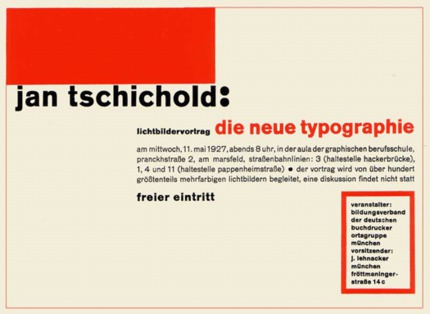
First published in 1928, Jan Tschichold's Die Neue Typographie ("The New Typography") revolutionized the way we thought about design by privileging clarity over beauty, though Tschichold showed us that both were, in fact, achievable: why, then, can't writing in general — and theory in particular — be seen as a boon to making great design?
When I first began to study graphic design in the early 1980s, I was puzzled as to why there was no theory, no substance or depth to the discussions that seemed so overwhelmingly grounded in formal language. Back then, we didn't speak of social missions or sustainable goals; there was no "user" and when we spoke of audience, it was our way of nodding gratuitiously to the demands of broad-based demographic research. (Obviously, long before the facility with which Google makes this achievable, this meant a trip to the library. Usually on foot.)
I longed for something more — something meatier —to qualify the choices I was making, to help me reflect upon and rationalize decisions that so quickly seemd to find their way into concrete choices. Architects had theory, so why didn't designers? Perplexed, I lobbied my advisors to consider giving me a degree in graphic design and architectural theory, claiming that, in the absence of real ideas — real books to read, true primary sources to guide my research — graphic design had no ideological grounding. They agreed, and granted my request, and off I went into the working world, hoping it would make a difference.
In truth, it made absolutely no difference in my chances to find employment. But it made all the difference in the world in my perspective which was then, as now, rooted in something more than visual appeal. Five years later I returned to Yale for grad school, and encountered similar obstacles. Reading was the enemy, I was told: it will hold you back so that you get so caught up in ideas, you can’t make anything. I disagreed, and headed to the library, sketchbook in hand. Reading and writing and drawing were, and have remained, the most utterly companionable activities I can imagine.
Today is our graduation day at Yale, and marks 30 years since my own commencement. We call it commencement because it is just that — a beginning — but where I began as a graphic designer and writer bears little resemblance to the way we think about and practice design today. I have always felt that writing was a way into design; and that design, in turn, was a way into writing. This double approach characterizes both my teaching and my studio practice, although for many years, this philosophy was seen as grim and onerous by the majority of my graduate students. Then blogging took hold, and suddenly, writing meant discussion. Writing meant social engagement. Writing became a way to collaborate, to develop an idea and move it — and by conjecture, yourself — forward. Now, everyone sees writing as a way in. (And sometimes, as a way out.) Today, graphic design is no longer a function of pictures and words on paper, because graphic design is no longer only about being graphic. It operates on multiple formal platforms, and its boundaries are porous and flexible, cultural and dynamic — visual and yes, verbal.
Today, we know that the audience is us, because graphic design both belongs to and is produced by everyone, inhabiting everything from Swiss dogma to skateboard graffiti. It resists definition, because it is everywhere, which means it is nowhere.
If there is a problem, the problem is this: once graphic design belongs to everyone, the role of the critic is tricky. Is it possible to both consume and contribute? To contribute and critique? Is it possible that our greatest critics might be most committed makers?
As a 30-year veteran of making and writing, I think it is not only possible but imperative that we strive to do both. Let’s teach our students to think about language. Let’s ask tough questions about why we make things. Let’s support the role of writing, the opportunity in reading, the value of a second language, the need for engaged criticism. Let’s remember that graphic design is about ideas, and ideas mean words — beautiful, descriptive, analytical and magical words. We write about graphic design, quite frankly, because we can.
To be published later this summer by Progetto Grafico, Italy
